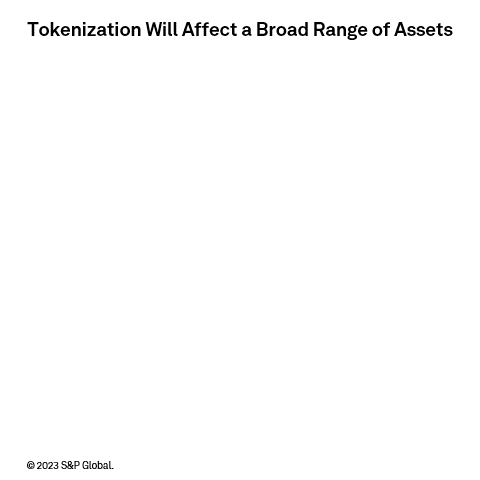The creation of a digital representation of a broadening array of rights and assets will enable a new scale of market efficiencies and democratize access to previously unavailable investment asset classes.
The crypto downturn and failure of FTX may impact general perceptions and policy formation, but they should not undermine the longer-term potential of tokenization; cryptocurrencies are a minor, though much-publicized, part of the potential tokenized universe.
The pace of transformation will be affected by the need for material investments and an evolution in laws and regulations.
The business models of numerous intermediaries will evolve or even disappear, but new types of service providers will emerge.
Tokenization — the conversion of assets and rights into a digital token on a blockchain — will likely upend by 2030 the transaction methods of many well-established asset classes, tangible or intangible. It will also enhance the accessibility of established asset classes, and allow the creation of new ones, for a broader range of investors in underserved frontier markets. It will spur growth in some corners and displace existing intermediaries in others. The investments in technology and skills as well as the changes in law and regulations that these shifts will require represent necessary hurdles in the transition. And while automation will eliminate certain intermediaries, new types of service providers should emerge to help manage the evolution in attendant risks.
The Main Attraction of Tokenization
Tokenization is the process of issuing a digital token that represents a tradable asset. The digital token can then be owned, used and transferred through a blockchain, reducing the need for third-party intermediaries. Higher profile tokens are often “native” ones, such as bitcoin and ether. But increasingly, tokenization is reaching a broad range of “real-world assets,” generally at very early stages of pilot schemes. In principle, anything featuring property rights and economic value can be tokenized. That includes tangible assets, such as property or physical works of art; intangible assets, such as intellectual property, digital art or wireless internet access; private equity (e.g., fund shares) or alternative investments (e.g., carbon credits); and debt and equity, whether listed or private (see chart).
In principle, anything featuring property rights and economic value can be tokenized.

The key expected benefits include the following:
- Accessibility/liquidity. Tokenization allows fractionalization, whereby investors can purchase tokens that represent very small shares of the underlying assets. This could democratize direct investment in more costly assets, such as commercial real estate. It could also boost access to underserved segments, for instance, in emerging markets, thereby supporting economic growth. This increased liquidity, especially if well-established standards emerge, has been compared to the benefits securitization brought as it gained scale.
- Efficiency. Technology and smart contracts can allow faster and lower-cost asset transfers by automating certain parts of the process — in particular, post-trade steps such as clearing and settlement — thereby reducing the need for intermediaries. Large trading pools such as the $200 trillion global fixed-income and equity markets¹ are prime candidates.
- Transparency. The immutable nature of the underlying technology prevents tampering. It allows potential new acquirers to know who they are dealing with, what rights and obligations are attached to the token, and who the previous owners are. Such traceability is very attractive, for example, for supply chain management.
- Privacy. Personal data is fully owned and controlled via decentralized identity by each individual or entity. They may provide only the information needed to be verified, with use cases, for instance, in the healthcare or insurance sectors.
Why It Won’t Be an Overnight Revolution
Cryptocurrencies are a fraction of the potential tokenized ecosystem. The crypto winter and default of several protocols and players do not impact the prospects of tokenization by 2030, but they have affected perceptions and short-term activity levels. The total value locked in protocols averaged about $50 billion in the second half of 2022, a fraction of its 2021 peak.
Stakeholders are using this period to advance policies and technology. Absent more progress, both elements will represent long-term bottlenecks. Fundamental questions include whether an asset can be foreclosed on if owned through a token. Progress among jurisdictions varies. Regulators will focus on maintaining financial stability, protecting consumers and ensuring responsible market conduct in the face of new products, processes and players. For example, the fractional ownership of assets previously reserved for institutional investors could expose retail investors to new risks. Fractionalization may therefore not be the impending revolution sometimes portrayed.
The fractional ownership of assets previously reserved for institutional investors could expose retail investors to new risks.
New technology will also advance, requiring large capex investments. Otherwise, capacity will constrain prospects for high-volume applications. In parallel, a tokenized central bank currency or stablecoin will be needed for payments. The lack of interoperability may also limit the fungibility of liquidity across blockchains, introduce an additional element of vulnerability and increase the risk of fragmentation in liquidity.
Likely Impacts
Some intermediaries will disappear, some will evolve and new ones will materialize. For tokenized bonds and equities, the need for a central counterparty to engage in clearing, settlement and custodian activities may disappear or be reduced. An agent will still be needed to provide a regulatorily approved platform, and know-your-customer and anti-money laundering obligations will remain. In addition, increased transparency in the price discovery mechanism may come at the expense of greater volatility in times of stress absent the current market makers.
Agents will impose themselves by 2030 to address the novel risks in the connection between off- and on-chain worlds. The role of reputable custodians guaranteeing the permanence of the link between tokens and the real assets they represent will be paramount. Also, as in the “real world,” governance is key to ensure stability, and evolutions such as fractionalized ownership will pose challenges. New investment opportunities and technologies will also require new advisory services, particularly around risks.
A tokenized future does not mean the emergence of a separate, virtual and totally decentralized ecosystem. For tokenization and its attendant benefits to scale up while containing risks, compromises and hybrid solutions are necessary. Intermediaries will still exist, even if they take new forms, and stakeholders must remain mindful of the emergence of new forms of concentration in some of these agents.



























